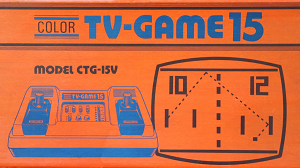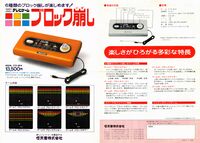| Site Notice |
|---|
|
We have a limited coverage policy. Please check our coverage page to see which articles are allowed. |
Difference between revisions of "Color TV-Game"
Torchickens (talk | contribs) |
m |
||
| (7 intermediate revisions by 3 users not shown) | |||
| Line 1: | Line 1: | ||
| − | '''Color TV-Game''' (カラーテレビゲーム) | + | [[File:Color TV Game 15.png|thumb|right|300px|Color TV-Game 15 boxart]] |
| + | '''Color TV-Game''' (カラーテレビゲーム) is a series of five consoles made by Nintendo between 1977 <ref name="ch6">https://www.computinghistory.org.uk/det/20732/Color-TV-Game-6/</ref> and 1980 <ref>http://blog.beforemario.com/2011/02/computer-tv-game-tv-1980.html</ref>. They are Nintendo's first gaming consoles. | ||
| − | The consoles include the ''[[Color TV Game 6]]'', ''[[Color TV Game 15]]'', ''[[Color TV Game Racing | + | The consoles include the ''[[Color TV-Game 6]]'', ''[[Color TV-Game 15]]'', both of which are based on Pong, ''[[Color TV-Game Racing 112]]'', a racing game, ''[[Color TV-Game Block Kuzushi]]'', based on Nintendo's arcade game ''[[Block Fever]]'', and ''[[Computer TV-Game]]'', which is based on ''[[Computer Othello]]'', another early arcade game made by Nintendo. |
| + | |||
| + | ==''Color TV-Game 6''== | ||
| + | The ''Color TV-Game 6'' was the first console in the Color TV-Game series, released in 1977. It features a game called Light Tennis, which is similar to Pong <ref name="ch6"/>. There are 3 variants of the game: hockey, volley ball and tennis. Each of these can be played as singles and as doubles. <ref name="bm6">http://blog.beforemario.com/2011/04/nintendo-color-tv-game-6-6-1977.html</ref>, which gives the console 6 different games. Singles has only one racket, and doubles has two. The switches on top of the console allow the player to set the size of the racket, the acceleration of the ball, whether to play singles or doubles, and the game variant.<ref name="bm6"/> | ||
| + | |||
| + | There are two variants of the ''Color TV-Game 6'', the CTG-6S, which was released initially, and the CTG-6V which was released later.<ref name="bm6"/>. The CTG-6S did not stop the player's racket at the edge of the screen. The CTG-6V prevented this from happening, which made the game easier to play.<ref name="bm6"/>. The consoles were also different colors. The CTG-6S was white, and the CTG-6V was orange. The controllers are also a little bit different.<ref name="bm6"/> | ||
| + | |||
| + | ==''Color TV-Game 15''== | ||
| + | The ''Color TV-Game 15'' was also released in 1977, only a week after the ''Color TV-Game 6''.<ref name="ch15">https://www.computinghistory.org.uk/det/42202/Color-TV-Game-15/</ref> It used the same main chip as the ''Color TV-Game 6'', but it had more games, and detachable controllers.<ref name="bm15">http://blog.beforemario.com/2012/01/nintendo-color-tv-game-15-15-1977.html</ref> | ||
| + | |||
| + | The console had 8 games: Tennis A, Tennis B, Volley A, Volley B, Hockey A, Hockey B, Ping Pong, and Shooting game. Each of these games, except Shooting game, could be played as singles or doubles. This gave the console 15 games. It also provided similar settings for racket size and ball speed as the ''Color TV-Game 6''.<ref name="bm15"/> | ||
| + | |||
| + | Like the ''Color TV-Game 6'', there are different versions. The earlier CTG-15S allowed the rotary controls to turn endlessly, but the CTG-15V would stop at a certain point to prevent the racket moving off the screen. There was also a version made by Sharp, the Color TV-Game XG-115, which was similar to the CTG-15V.<ref name="bm15"/> | ||
| + | |||
| + | ==''Color TV Game Racing 112''== | ||
| + | ''Color TV Game Racing 112'' was released on the 8th June 1978.<ref name="chr112">https://www.computinghistory.org.uk/det/58228/Color-TV-Game-Racing-112/</ref>. It has a racing game, where players drive along the screen vertically and avoid other cars.<ref name="chr112"/>The objective of the game is to pass as many cars as possible. The controller built into the console features a steering wheel and a gear-shift, which could switch between 2 gears.<ref name="bmr112">http://blog.beforemario.com/2011/05/nintendo-color-tv-game-racing-112-112.html</ref> It also included two paddle controllers, which are used for the two player mode.<ref name="bmr112"/> | ||
| + | |||
| + | There are 3 game modes, "spacious course" and "narrow course" which are both single player, and the two player mode. The speed of the game can be picked from 3 settings, low, medium and high. The opponent cars' zigzagging can be enabled or disabled. There is also an option to enable or disable whether touching the guard rail crashes the car, as well as a "bad road" option.<ref name="bmr112"/> | ||
| + | |||
| + | ==''Color TV Game Block Kuzushi''== | ||
| + | [[File:Block breaker leaflet 01.jpg|thumb|200px|Leaflet for ''Color TV Game Block Kuzushi'']] | ||
| + | ''Color TV Game Block Kuzushi'', which means "block breaker", is the fourth Color TV-Game console. It is based on Nintendo's arcade game ''[[Block Fever]]'', which is similar to Atari's ''Breakout''. The housing of the ''Color TV Game Block Kuzushi'' was designed by [[Shigeru Miyamoto]]. This was one of his first video game projects.<ref name="chbk">https://www.computinghistory.org.uk/det/42314/Color-TV-Game-Block-Breaker/</ref> | ||
| + | |||
| + | The game has 6 variants, which have different layouts of blocks, and different objectives.<ref name="bmbk">http://blog.beforemario.com/2011/05/nintendo-color-tv-game-block-kuzushi.html</ref> | ||
| + | |||
| + | ==''Computer TV Game''== | ||
| + | The final console in the Color TV Game series is the ''Computer TV Game''. It was released in 1980, and is based on the arcade game ''[[Computer Othello]]''. It can be played against the computer, or against another player.<ref>http://blog.beforemario.com/2011/02/computer-tv-game-tv-1980.html</ref> | ||
| + | ==References== | ||
| + | {{ref}} | ||
| + | [[Category:Color TV-Games|*]] | ||
Latest revision as of 15:01, 23 November 2023
Color TV-Game (カラーテレビゲーム) is a series of five consoles made by Nintendo between 1977 [1] and 1980 [2]. They are Nintendo's first gaming consoles.
The consoles include the Color TV-Game 6, Color TV-Game 15, both of which are based on Pong, Color TV-Game Racing 112, a racing game, Color TV-Game Block Kuzushi, based on Nintendo's arcade game Block Fever, and Computer TV-Game, which is based on Computer Othello, another early arcade game made by Nintendo.
Contents
Color TV-Game 6
The Color TV-Game 6 was the first console in the Color TV-Game series, released in 1977. It features a game called Light Tennis, which is similar to Pong [1]. There are 3 variants of the game: hockey, volley ball and tennis. Each of these can be played as singles and as doubles. [3], which gives the console 6 different games. Singles has only one racket, and doubles has two. The switches on top of the console allow the player to set the size of the racket, the acceleration of the ball, whether to play singles or doubles, and the game variant.[3]
There are two variants of the Color TV-Game 6, the CTG-6S, which was released initially, and the CTG-6V which was released later.[3]. The CTG-6S did not stop the player's racket at the edge of the screen. The CTG-6V prevented this from happening, which made the game easier to play.[3]. The consoles were also different colors. The CTG-6S was white, and the CTG-6V was orange. The controllers are also a little bit different.[3]
Color TV-Game 15
The Color TV-Game 15 was also released in 1977, only a week after the Color TV-Game 6.[4] It used the same main chip as the Color TV-Game 6, but it had more games, and detachable controllers.[5]
The console had 8 games: Tennis A, Tennis B, Volley A, Volley B, Hockey A, Hockey B, Ping Pong, and Shooting game. Each of these games, except Shooting game, could be played as singles or doubles. This gave the console 15 games. It also provided similar settings for racket size and ball speed as the Color TV-Game 6.[5]
Like the Color TV-Game 6, there are different versions. The earlier CTG-15S allowed the rotary controls to turn endlessly, but the CTG-15V would stop at a certain point to prevent the racket moving off the screen. There was also a version made by Sharp, the Color TV-Game XG-115, which was similar to the CTG-15V.[5]
Color TV Game Racing 112
Color TV Game Racing 112 was released on the 8th June 1978.[6]. It has a racing game, where players drive along the screen vertically and avoid other cars.[6]The objective of the game is to pass as many cars as possible. The controller built into the console features a steering wheel and a gear-shift, which could switch between 2 gears.[7] It also included two paddle controllers, which are used for the two player mode.[7]
There are 3 game modes, "spacious course" and "narrow course" which are both single player, and the two player mode. The speed of the game can be picked from 3 settings, low, medium and high. The opponent cars' zigzagging can be enabled or disabled. There is also an option to enable or disable whether touching the guard rail crashes the car, as well as a "bad road" option.[7]
Color TV Game Block Kuzushi
Color TV Game Block Kuzushi, which means "block breaker", is the fourth Color TV-Game console. It is based on Nintendo's arcade game Block Fever, which is similar to Atari's Breakout. The housing of the Color TV Game Block Kuzushi was designed by Shigeru Miyamoto. This was one of his first video game projects.[8]
The game has 6 variants, which have different layouts of blocks, and different objectives.[9]
Computer TV Game
The final console in the Color TV Game series is the Computer TV Game. It was released in 1980, and is based on the arcade game Computer Othello. It can be played against the computer, or against another player.[10]
References
- ↑ 1.0 1.1 https://www.computinghistory.org.uk/det/20732/Color-TV-Game-6/
- ↑ http://blog.beforemario.com/2011/02/computer-tv-game-tv-1980.html
- ↑ 3.0 3.1 3.2 3.3 3.4 http://blog.beforemario.com/2011/04/nintendo-color-tv-game-6-6-1977.html
- ↑ https://www.computinghistory.org.uk/det/42202/Color-TV-Game-15/
- ↑ 5.0 5.1 5.2 http://blog.beforemario.com/2012/01/nintendo-color-tv-game-15-15-1977.html
- ↑ 6.0 6.1 https://www.computinghistory.org.uk/det/58228/Color-TV-Game-Racing-112/
- ↑ 7.0 7.1 7.2 http://blog.beforemario.com/2011/05/nintendo-color-tv-game-racing-112-112.html
- ↑ https://www.computinghistory.org.uk/det/42314/Color-TV-Game-Block-Breaker/
- ↑ http://blog.beforemario.com/2011/05/nintendo-color-tv-game-block-kuzushi.html
- ↑ http://blog.beforemario.com/2011/02/computer-tv-game-tv-1980.html

